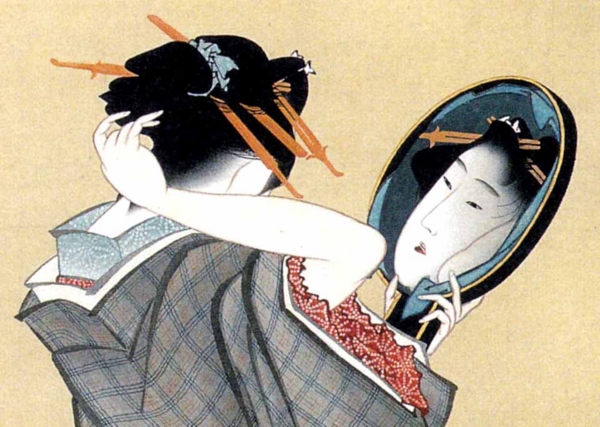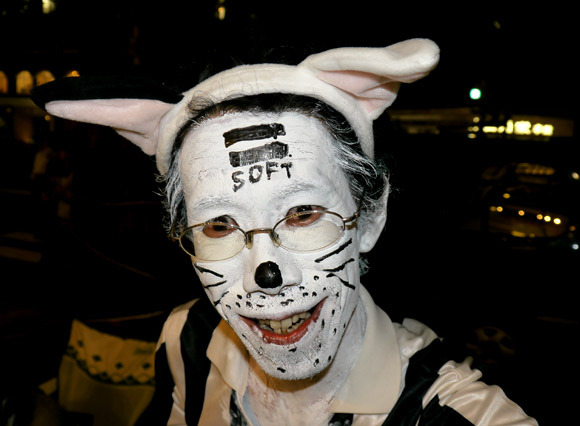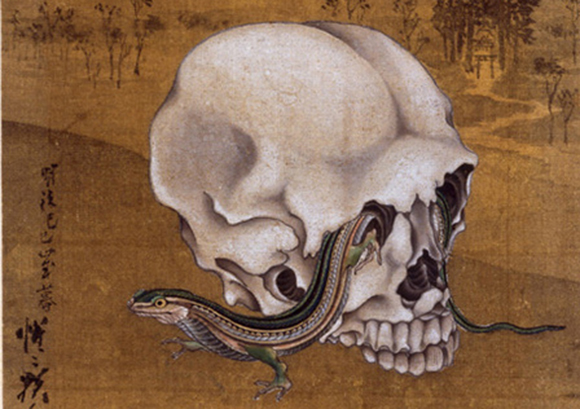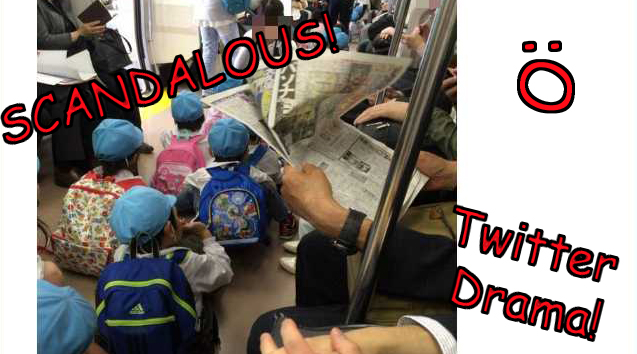After the initial dust settles on the scene of a tragedy there comes the more protracted, but often less news-worthy, battle for answers and accountability. From the outset Korean authorities have come under fire from the public as well as government officials who claim that the immediate response to the incident was not good enough, and the accusations of incompetence continue to mount.
Posted by Cara Clegg (Page 11)
Japanese people love their cup noodles, there’s now doubt about it. You can see endless varieties on sale at the conbini or supermarket, from the ordinary to the weird and wonderful. Recently Nissin Foods has released two limited edition cup noodle flavours to be sold at AEON which are definitely at the weirder end of the scale: Cheeseburger Noodles and Hot Dog Noodles.
After Japan’s hopes of advancing in the World Cup were dashed by a 1-4 defeat to Colombia, Japanese football fans have been looking for something to get them smiling again. And Ivory Coast’s goalie provided just the opportunity.
It all started with the Japanese version of “Let it Go”, the hit song from Disney’s latest animated movie Frozen. But that wasn’t the only song to be localized, and now amateur singers are getting even more local with creative versions of Frozen’s songs in their own regional dialects. Join us after the jump for two of the best.
Some of Japan’s most famous characters created by legendary manga-ka Fujiko F Fujio have been turned into robots by Bandai, which can then be combined to create an even more epicly-super-cool robot of retro awesomeness!
Beauty standards and trends differ from culture to culture, so something that’s fashionable and pretty to one woman can be completely can be bizarre, sometimes even ugly, to another half the world away. This is especially true in the case of Japanese beauty fads, which often leave Westerners thinking, “Why on earth are you doing that to yourself?!’ while Japanese fashion magazines insist that it’s the path to ultimate kawaii-ness.
Read on for four Japanese beauty fads that are all the rage among Japanese girls, but which are hard to understand from a Western perspective.
Have you ever had that experience where you’ve left the house in a good mood, convinced that you look great, until you catch a glimpse of yourself in a shop window or a reflective surface and then your whole day is ruined? You were sure when you left the house that morning that your makeup was done to perfection, and you looked healthy and vibrant, but now it’s like you’re looking at a different person, someone who’s about ten years older and hasn’t slept for a week.
What does it mean to be human? That’s the question being asked in a thought-provoking new exhibition of stunningly lifelike androids, which also suggests that maybe the singularity could be closer than we think.
There’s now less than a week left until the 2014 FIFA World Cup in Brazil, and media and businesses all over the world are gearing up. Japan is no exception, with celebratory events going on and brands rushing to launch special themed products. In amongst it all, one particular advert from Cup Noodle maker Nissin has caught our eye for its great combination of traditional Japan and modern Brazil.
Crossdressing and genderbending are not only long-time staples of Japanese anime and manga, but also of TV and celebrity culture. From this, anyone would think that Japan was one of the most open and accepting countries when it comes to people who don’t fit into traditional gender roles or relationships. However, the reality outside of media and entertainment is often quite different. Family and work life are both still clearly divided down gender lines, and men who engage in anything that blurs or crosses these lines are generally shunned. But could the girl who dumps a guy just because he turns up to a date in a dress be the one who’s really missing out?
There are so many 2-D girls out there with different hairstyles and colours, body shapes, and personalities, although they do all share the same big googly eyes. And apparently the sexiest of them all share something else in common too. Did your waifu make this list of the top 10 sexiest female anime characters?
Japan is no stranger to natural disasters, and the world rose up in support after the devastating earthquake and tsunami in 2011 left thousands dead and millions homeless. Now it’s time for Japanese people to repay that kindness by supporting one of their greatest benefactors through their own period of crisis.
Japan probably has the world’s largest and most bizarre selection of Kit Kat flavours on offer, but this latest release is about more than just tickling your tastebuds. Nestle Japan is offering a specially-packaged version of their classic biscuit to help recovery in areas destroyed by the devastating tsunami of March 2011.
The Asahi Beer Oyamazaki Villa Museum of Art is located in Yamazaki, a place of historical significance in Japan since medieval times when it served as a field of battle for Toyotomi Hideyoshi to avenge the betrayal and murder of his lord Oda Nobuaga. The museum is currently hosting an exhibition that pays homage to the samurai of those ancient times, in a very modern and surreal fashion.
As a cat owner, I’m used to having cat hair on absolutely everything. But every so often in amongst the clouds of fur I find a dropped whisker lying alone on the floor, and for some reason it feels wrong to just throw it away. Turns out I’m not alone, and some people go a few steps further when it comes to storing these precious mementos of their feline friends.
Director Gareth Edwards’ new take on Godzilla takes full advantage of the latest advancements in CGI technology to bring the iconic monster back to life, bigger and badder than ever before, and the promotional posters and teaser trailers stirred up plenty of hype before the movie’s release. But would you be rushing into the movie theater if you saw the above poster?
When you think of Japanese ukiyo-e, or woodblock prints, you probably think of Hokusai’s beautiful landscapes in his Thirty Six Views of Mount Fuji, or the stylized prints of beautiful courtesans in traditional Japanese dress. But there are also many pieces of Japanese art and ukiyo-e from the Edo to the Meiji period (between 1603 and 1912) that represent a more mythical and macabre side of Japan.
The following is a collection of 20 pieces that all contain skulls or skeletons in some form, many of them by renowned and famous artists of the time.
Every Japanese person knows about kappa, the tricksy and sometimes dangerous, yet strangely polite, water demons from ancient folklore. But how many have actually seen one in real life?
Next month, people will have the chance to, when parts of a supposedly real kappa go on display in all their mummified glory.
For some of our Western readers, just the idea of raw fish might be enough to turn stomachs. Now imagine the kind of sushi that even Japanese folk can’t handle. We’ve previously introduced Hong Kong’s ‘Myosho sushi’ store, nicknamed ‘killer sushi’, on our Japanese site, but in the name of journalism we decided that a hands-on report was necessary. And so we sent our brave and strong-stomached writer out into the field.




















 We found possibly the quietest Japanese-style hotel in Tokyo’s bustling Shinjuku district
We found possibly the quietest Japanese-style hotel in Tokyo’s bustling Shinjuku district Japan’s Hello Kitty Airport theming gets extension, avoids autumn end
Japan’s Hello Kitty Airport theming gets extension, avoids autumn end Survey finds more than 70 percent of Japanese children have an online friend
Survey finds more than 70 percent of Japanese children have an online friend New Japanese menstrual product seeks to help women spot unidentified iron deficiencies
New Japanese menstrual product seeks to help women spot unidentified iron deficiencies Japanese thug wear from Birth Japan perfect for those breaking bad next year
Japanese thug wear from Birth Japan perfect for those breaking bad next year Embroidered Laputa: Castle in the Sky clock catches the attention of Studio Ghibli
Embroidered Laputa: Castle in the Sky clock catches the attention of Studio Ghibli Japan’s new “sex tent” targets campers who’re more than friends, not yet lovers
Japan’s new “sex tent” targets campers who’re more than friends, not yet lovers Massive Godzilla figure stands more than six feet tall, costs more than $40,000
Massive Godzilla figure stands more than six feet tall, costs more than $40,000 All-Japan Gravure Awards salute Japan’s best swimwear and cosplay models【Photos】
All-Japan Gravure Awards salute Japan’s best swimwear and cosplay models【Photos】 More Than a Capsule Stay: Why Solo Travelers Choose “global cabin Yokohama Chinatown”
More Than a Capsule Stay: Why Solo Travelers Choose “global cabin Yokohama Chinatown” Starbucks Japan ready to get Year of the Horse started with adorable drinkware and plushies【Pics】
Starbucks Japan ready to get Year of the Horse started with adorable drinkware and plushies【Pics】 Lacquerware supplier to emperor of Japan and Pokémon team up for new tableware
Lacquerware supplier to emperor of Japan and Pokémon team up for new tableware Japan may add Japanese language proficiency, lifestyle classes to permanent foreign resident requirements
Japan may add Japanese language proficiency, lifestyle classes to permanent foreign resident requirements 7-Eleven Japan’s ramen-cooking robot whipped us up a bowl of noodles【Taste test】
7-Eleven Japan’s ramen-cooking robot whipped us up a bowl of noodles【Taste test】 Cyberpunk anime meets traditional culture in Ghost in the Shell gold leaf Japanese changing screens
Cyberpunk anime meets traditional culture in Ghost in the Shell gold leaf Japanese changing screens Disillusionment at Tsukiji’s tourist-target prices led us to a great ramen restaurant in Tokyo
Disillusionment at Tsukiji’s tourist-target prices led us to a great ramen restaurant in Tokyo 7 great places to see Mt. Fuji from without having to climb it
7 great places to see Mt. Fuji from without having to climb it Hello Kitty Choco Egg figures are an adorable trip through three periods of Japanese pop culture【Pics】
Hello Kitty Choco Egg figures are an adorable trip through three periods of Japanese pop culture【Pics】 Starbucks Japan releases new zodiac chilled cup drink for 2026
Starbucks Japan releases new zodiac chilled cup drink for 2026 Japan’s otoshidama tradition of giving kids money at New Year’s gets a social welfare upgrade
Japan’s otoshidama tradition of giving kids money at New Year’s gets a social welfare upgrade 7-Eleven Japan starts new temporary luggage storage service in over 300 branches
7-Eleven Japan starts new temporary luggage storage service in over 300 branches Starbucks teams up with 166-year-old Kyoto doll maker for Year of the Horse decorations【Photos】
Starbucks teams up with 166-year-old Kyoto doll maker for Year of the Horse decorations【Photos】 Tokyo considering law requiring more trash cans following litter increase in heavily touristed area
Tokyo considering law requiring more trash cans following litter increase in heavily touristed area Tokyo’s Tsukiji sushi neighborhood asks tour groups to stay away for the rest of the month
Tokyo’s Tsukiji sushi neighborhood asks tour groups to stay away for the rest of the month Nintendo’s Kirby now delivering orders at Kura Sushi restaurants, but not in Japan
Nintendo’s Kirby now delivering orders at Kura Sushi restaurants, but not in Japan Tokyo event lets you travel back in time, for free, to celebrate 100 years since Showa era start
Tokyo event lets you travel back in time, for free, to celebrate 100 years since Showa era start Sanrio theme park in Japan announces plans to expand into a Sanrio resort
Sanrio theme park in Japan announces plans to expand into a Sanrio resort Stamina-destroying “Paralysis Noodles” are Tokyo’s newest over-the-top ramen innovation
Stamina-destroying “Paralysis Noodles” are Tokyo’s newest over-the-top ramen innovation Survey asks foreign tourists what bothered them in Japan, more than half gave same answer
Survey asks foreign tourists what bothered them in Japan, more than half gave same answer Japan’s human washing machines will go on sale to general public, demos to be held in Tokyo
Japan’s human washing machines will go on sale to general public, demos to be held in Tokyo Japan’s deadliest food claims more victims, but why do people keep eating it for New Year’s?
Japan’s deadliest food claims more victims, but why do people keep eating it for New Year’s? We deeply regret going into this tunnel on our walk in the mountains of Japan
We deeply regret going into this tunnel on our walk in the mountains of Japan Studio Ghibli releases Kodama forest spirits from Princess Mononoke to light up your home
Studio Ghibli releases Kodama forest spirits from Princess Mononoke to light up your home Major Japanese hotel chain says reservations via overseas booking sites may not be valid
Major Japanese hotel chain says reservations via overseas booking sites may not be valid Put sesame oil in your coffee? Japanese maker says it’s the best way to start your day【Taste test】
Put sesame oil in your coffee? Japanese maker says it’s the best way to start your day【Taste test】 No more using real katana for tourism activities, Japan’s National Police Agency says
No more using real katana for tourism activities, Japan’s National Police Agency says Starbucks Japan reveals new sakura drinkware collection, inspired by evening cherry blossoms
Starbucks Japan reveals new sakura drinkware collection, inspired by evening cherry blossoms Updated cherry blossom forecast shows extra-long sakura season for Japan this year
Updated cherry blossom forecast shows extra-long sakura season for Japan this year Embroidered Laputa: Castle in the Sky clock catches the attention of Studio Ghibli
Embroidered Laputa: Castle in the Sky clock catches the attention of Studio Ghibli Japan’s new “sex tent” targets campers who’re more than friends, not yet lovers
Japan’s new “sex tent” targets campers who’re more than friends, not yet lovers Massive Godzilla figure stands more than six feet tall, costs more than $40,000
Massive Godzilla figure stands more than six feet tall, costs more than $40,000 All-Japan Gravure Awards salute Japan’s best swimwear and cosplay models【Photos】
All-Japan Gravure Awards salute Japan’s best swimwear and cosplay models【Photos】 More Than a Capsule Stay: Why Solo Travelers Choose “global cabin Yokohama Chinatown”
More Than a Capsule Stay: Why Solo Travelers Choose “global cabin Yokohama Chinatown” Maximum matcha! Tokyo sweet shop sells the strongest green tea chocolates physically possible
Maximum matcha! Tokyo sweet shop sells the strongest green tea chocolates physically possible Abysmal viewer ratings for Pokémon anime series does not worry its broadcaster the slightest bit
Abysmal viewer ratings for Pokémon anime series does not worry its broadcaster the slightest bit Happy New Year from SoraNews24!
Happy New Year from SoraNews24! Tokyo sakura report: Why Shinjuku Gyoen beats Ueno Park for hanami cherry blossom viewing
Tokyo sakura report: Why Shinjuku Gyoen beats Ueno Park for hanami cherry blossom viewing This is possibly the coziest train in all Japan thanks to onboard hot spring footbaths【Pics】
This is possibly the coziest train in all Japan thanks to onboard hot spring footbaths【Pics】 Studio Ghibli releases bonsai fountains for your home
Studio Ghibli releases bonsai fountains for your home Nagoya’s dark-red miso has continued to capture tastebuds for generations
Nagoya’s dark-red miso has continued to capture tastebuds for generations Japanese hot spring YouTuber finds her niche showing off out-of-the-way local onsen【Videos】
Japanese hot spring YouTuber finds her niche showing off out-of-the-way local onsen【Videos】